Paleoproterozoic Mafic and Ultramafic Rocks from the Mako Belt, Senegal: Implications for Back-Arc Basin Origin
Abstract
1. Introduction
2. Materials and Methods
2.1. Field Observations and Sampling
2.2. Sample Processing and Analytical Methods
3. Results
3.1. Petrography and Mineral Chemistry
3.2. Whole Rock Major and Trace Element Geochemistry
4. Discussion
4.1. Classification and Tectonic Setting of Mako Belt Mafic and Ultramafic Rocks
4.2. Geochemical Evidence for Subduction Influence in the Basalts
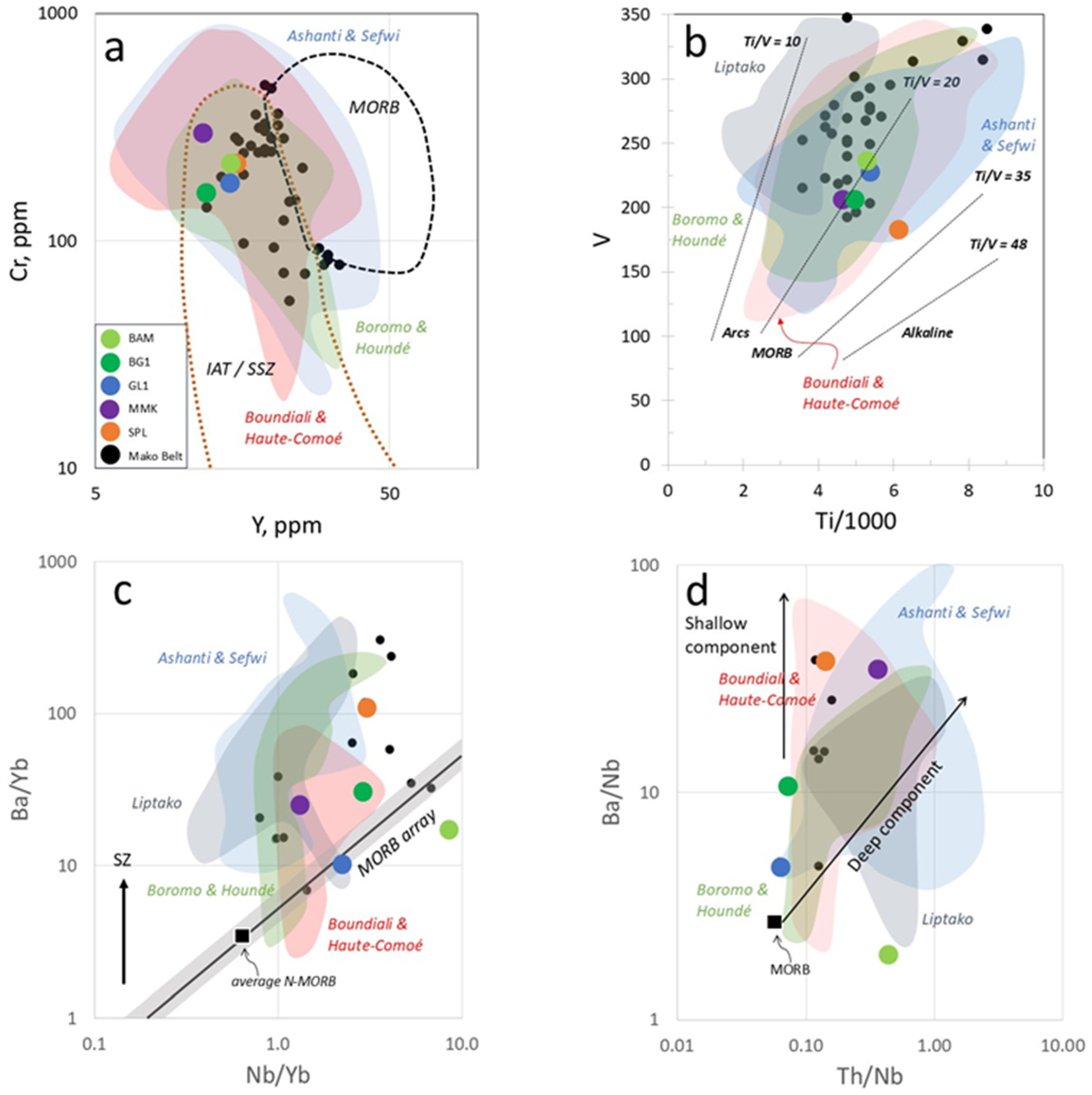
4.3. Nature and Origin of the Ultramafic Rocks
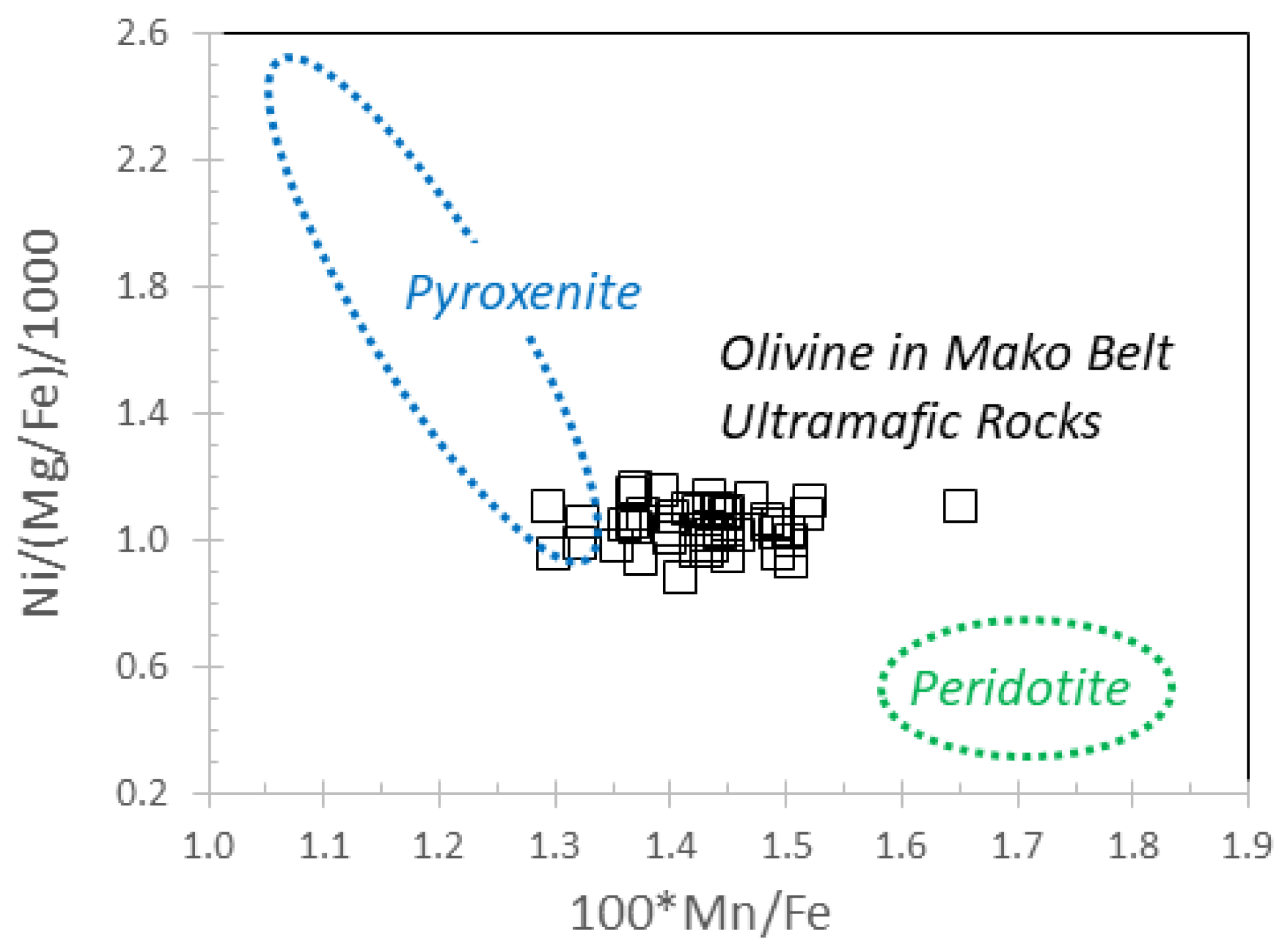
4.4. Regional Tectonic Implications: Arc Accretion and WAC Architecture
4.5. Geodynamic Model
5. Conclusions
- Mafic lavas in the Mako Belt—preserved as massive and pillowed flows—exhibit geochemical features consistent with magmatism in a subduction-modified mantle wedge. Some samples display (Nb/La)PM > 1, indicating partial melting of an enriched source, typical of back-arc basin environments. Harzburgites and lherzolites with cumulate textures, high Cr and Ni contents, and spinel Cr# > 0.6 have REE patterns parallel to those of the basalts, supporting a cogenetic relationship.
- The geochemical data are best explained by formation in a Paleoproterozoic back-arc basin associated with subduction, rather than by plume-related or mid-ocean ridge processes. The coexistence of arc-like and back-arc-like geochemical traits is interpreted as the result of melt generation in a heterogeneously metasomatized subarc mantle wedge, possibly influenced by slab rollback.
- Comparison with other SWAC greenstone belts (e.g., Boromo, Boundiali) suggests that the Mako Belt was part of a broader convergent margin system. These belts likely formed in distinct arc and back-arc settings and were progressively accreted onto the West African Craton during the Eburnean orogeny (~2.10–2.00 Ga).
- The proposed geodynamic model reinforces the view that modern-style plate tectonics—including subduction and arc–back-arc magmatism—was already active in the Paleoproterozoic. The Mako Belt offers an important window into these early processes and contributes to ongoing debates on crustal growth mechanisms during the assembly of early cratonic nuclei.
Supplementary Materials
Author Contributions
Funding
Data Availability Statement
Acknowledgments
Conflicts of Interest
References
- Condie, K.C.; O’Neill, C.; Aster, R.C. Evidence and implications for widespread magmatic shutdown for 250 My on Earth. Earth Planet. Sci. Lett. 2009, 282, 294–298. [Google Scholar] [CrossRef]
- Cawood, P.A.; Hawkesworth, C.J.; Pisarevsky, S.A.; Dhuime, B.; Capitanio, F.A.; Nebel, O. Geological archive of the onset of plate tectonics. Philos. Trans. R. Soc. A 2018, 376, 20170405. [Google Scholar] [CrossRef]
- Bédard, J.H. A catalytic delamination-driven model for coupled genesis of Archaean crust and sub-continental lithospheric mantle. Geochim. Cosmochim. Acta 2006, 70, 1188–1214. [Google Scholar] [CrossRef]
- Hamilton, W.B. Plate tectonics began in Neoproterozoic time, and plumes from deep mantle have never operated. Lithos 2011, 123, 1–20. [Google Scholar] [CrossRef]
- Milési, J.P.; Feybesse, J.L.; Ledru, P.; Dommanget, A.; Ouedraogo, M.F.; Tegyey, M.; Calvez, J.Y.; Lagny, P. Les mineralisations auriferes de lʼAfrique de lʼOuest; leur evolution lithostructurale au Proterozoique inferieur. Chron. De La Rech. Min. 1989, 497, 3–98. [Google Scholar]
- Dia, A.; van Schmus, W.R.; Kröner, A. Isotopic constraints on the age and formation of a Palaeoproterozoic volcanic arc complex in the Kedougou Inlier, eastern Senegal, West Africa. J. Afr. Earth Sci. 1997, 24, 197–213. [Google Scholar] [CrossRef]
- Feybesse, J.L.; Milési, J.P. The Archaean/Proterozoic contact zone in West Africa: A mountain belt of décollement thrusting and folding on a continental margin related to 2.1 Ga convergence of Archaean cratons? Precambrian Res. 1994, 69, 199–227. [Google Scholar] [CrossRef]
- Guéye, M.; Siegesmund, S.; Wemmer, K.; Pawlig, S.; Drobe, M.; Nolte, N.; Layer, P. New evidences for an early Birimian evolution in the West African Craton: An example from the Kedougou-Kenieba inlier, southeast Senegal. S. Afr. J. Geol. 2007, 110, 511–534. [Google Scholar] [CrossRef]
- Diallo, M.; Baratoux, L.; Dufrechou, G.; Jessel, M.W.; Vanderhaeghe, O.; Ly, S.; Baratoux, D. Structure of the Paleoproterozoic Kedougou-Kenieba Inlier (Senegal-Mali) deduced from gravity and aeromagnetic data. J. Afr. Earth Sci. 2020, 162, 103732. [Google Scholar] [CrossRef]
- Grenholm, M.; Jessell, M.; Thébaud, N. A geodynamic model for the Paleoproterozoic (ca. 2.27–1.96 Ga) Birimian Orogen of the southern West African Craton–Insights into an evolving accretionary-collisional orogenic system. Earth Sci. Rev. 2019, 192, 138–193. [Google Scholar] [CrossRef]
- Ngom, P.M.; Cordani, U.G.; Teixeira, W.; Assis Janasi, V. Sr and Nd isotopic geochemistry of the early ultramafic-mafic rocks of the Mako bimodal volcanic belt of the Kedougou-Kenieba inlier (Senegal). Arab. J. Geosci. 2010, 3, 49–57. [Google Scholar] [CrossRef]
- Labou, I.; Benoit, M.; Baratoux, L.; Grégoire, M.; Ndiaue, P.M.; Thebaud, N.; Béziat, D.; Debat, P. Petrological and geochemical study of Birimian ultramafic rocks within the West Africa Craton: Insights from Make (Senegal) and Loraboué (Burkina Faso) lherzolite/harzburgite/wehrlite associations. J. Afr. Earth Sci. 2020, 162, 103677. [Google Scholar] [CrossRef]
- Abouchami, W.; Boher, M.; Michard, A.; Albarède, F. A major 2.1 Ga event of mafic magmatism in West Africa: An early stage of crustal accretion. J. Geophys. Res. 1990, 95, 17605–17629. [Google Scholar] [CrossRef]
- Boher, M.; Abouchami, W.; Michard, A.; Albarede, F.; Arndt, N.T. Crustal growth in west Africa at 2.1 Ga. J. Geophys. Res. 1992, 97, 345–369. [Google Scholar] [CrossRef]
- Bassot, J.P. Le complexe volcano-plutonique calco-alcali de la riviere dalema (Est Senegal): Discussion de sa signification geodynamique dans le cadre de l’orogenie eburneenne (proterozoique inferieur). J. Afr. Earth Sci. 1987, 6, 505–519. [Google Scholar] [CrossRef]
- Pouclet, A.; Doumbia, S.; Vidal, M. Geodynamic setting of the Birimian volcanism in central Ivory Coast (western Africa) and its place in the Palaeoproterozoic evolution of the Man Shield. Bull. De La Société Géologique De Fr. 2006, 177, 105–121. [Google Scholar] [CrossRef]
- Dia, A. Caractéres et Signification des Complexes Magmatiques et Métamorphiques du Secteur de Sandikounda-Laminia (Nord de la Boutonnière de Kédougou, Est du Sénégal): Un Modèle Géodynamique du Birimien de L’Afrique de L’Ouest. Ph.D. Thesis, University of Dakar, Dakar, Senegal, 1988; 350p. [Google Scholar]
- Kone, J.; Vandergaeghe, O.; Diatta, F.; Baratoux, L.; Thebaud, N.; Brugier, O.; Ndiaye, P.M.; Duchene, S.; Pitra, P.; Ganne, J. Source and deposition age of the Dialé-Daléma metasedimentary series (Kédougou-Kéniéba Inlier, Senegal) constrained by U-Pb geochronology on detrital zircon grains. J. Afr. Earth Sci. 2020, 165, 103801. [Google Scholar] [CrossRef]
- Hirdes, W.; Davis, D.W. U–Pb geochronology of paleoproterozoic rocks in the southern part of the Kedougou-Kenieba Inlier, Senegal, West Africa: Evidence for diachronous accretionary development of the Eburnean province. Precambrian Res. 2002, 118, 83–99. [Google Scholar] [CrossRef]
- Diallo, D.P. Le paléovolcanisme de la bordure occidentale de la boutonnière de Kédougou, Paléoprotérozoïque du Sénégal oriental: Incidences géotectoniques. J. Afr. Earth Sci. 2001, 32, 919–940. [Google Scholar] [CrossRef]
- Labou, I.; Velasquez, G.; Benoit, M.; Baratoux, L.; Beziat, D.; Debat, P.; Ndiaye, P.M. Revisiting a geodynamic model for the Mako greenstone belt: New evidence for a Paleoproterozoic oceanic plateau in the West African Craton. EGUsphere 2025, 1–37. [Google Scholar] [CrossRef]
- Ingamells, C.O. Lithium metaborate flux in silicate analysis. Anal. Chim. Acta 1970, 52, 323–334. [Google Scholar] [CrossRef]
- Ngom, P.M.; Guéye, M.; Cissokho, S.; Joron, J.L.; Teruil, M.; Dabo, M. Signification géodynamique des roches volcaniques dans les ceintures de coches vertes d’ȃge Paléoprotérozoique. Exemple de la partie méridionale du Supergroupe de Mako, boutonnière de Kédougou (Sénégal). Approche des éléments en traces. J. Des Sci. Technol. 2007, 4, 52–57. [Google Scholar]
- Ngom, P.M. Caractères géochimiques des formations birrimiennesdu supergroupe de Mako (Sabodala et ses environs). J. Afr. Earth Sci. 1989, 8, 91–97. [Google Scholar] [CrossRef]
- Dick, H.J.B.; Bullen, T. Chromian spinel as a petrogenetic indicator in abyssal and alpine-type peridotites and spatially associated lavas. Contrib. Mineral. Petrol. 1984, 86, 54–76. [Google Scholar] [CrossRef]
- Barnes, S.J.; Roeder, P.L. The range of spinel compositions in terrestrial mafic and ultramafic rocks. J. Pet. 2001, 42, 2279–2302. [Google Scholar] [CrossRef]
- Stevens, R.E. Composition of some chromites of the Western hemisphere. Am. Mineral. 1944, 29, 1–34. [Google Scholar]
- Whattam, S.A.; De Hoog, J.C.M.; Leybourne, M.I.; Khedr, M.Z. Link between melt-impregnation and metamorphism of Atlantis Massif peridotite (IODP Expedition 357). Contrib. Mineral. Petrol. 2022, 177, 106. [Google Scholar] [CrossRef]
- Arai, S.; Yurimoto, H. Podiform chromitites of the Tari-Misaka ultramafic complex, southwestern Japan, as mantle-melt interaction products. Econ. Geol. 1994, 89, 1279–2188. [Google Scholar] [CrossRef]
- Nelson, W.R.; Dawson, M.J.; Piccoli, P.; Pitcavage, E.; Furman, T. Exploring the origin of pyroxenites using spinel compositions of Western Rift Ugandan xenoliths. In Proceedings of the AGU Fall Meeting Abstracts, Online, 1–17 December 2020; Volume 2020, p. DI002-0003. [Google Scholar]
- Pearce, J.A.; Stern, R. Origin of back-arc basin magmas: Trace element and isotope perspectives. In Back-Arc Spreading Systems: Geological, Biological, Chemical, and Physical Interactions; American Geophysical Union: Washington, DC, USA, 2006; Volume 166, pp. 63–86. [Google Scholar]
- Grenholm, M. The global tectonic context of the ca. 2.27-1.96 Ga Birimian Orogen—Insights from comparative studies, with implications for supercontinent cycles. Earth Sci. Rev. 2019, 193, 260–298. [Google Scholar] [CrossRef]
- Sun, S.S.; McDonough, W.F. Chemical and isotopic systematics of oceanic basalts: Implications for mantle composition and processes. Geol. Soc. Lond. Spec. Pub. 1989, 42, 313–345. [Google Scholar] [CrossRef]
- Sayit, K. Immobile trace element systematics of ocean island basalts: The role of oceanic lithosphere in creating the geochemical diversity. Ofioliti 2013, 38, 101–120. [Google Scholar]
- Mullen, E.D. MnO/TiO2/P2O5: A minor element discriminant for basaltic rocks of oceanic environments and its implications for petrogenesis. Earth Planet. Sci. Lett. 1983, 62, 53–62. [Google Scholar] [CrossRef]
- Winchester, J.A.; Floyd, P.A. Geochemical discrimination of different magma series and their differentiation products using immobile elements. Chem. Geol. 1977, 20, 325–343. [Google Scholar] [CrossRef]
- Beard, J.S. Characteristic mineralogy of arc-related cumulate gabbros: Implications for the tectonic setting of gabbroic plutons and for andesite genesis. Geology 1986, 14, 848–851. [Google Scholar] [CrossRef]
- Parlak, O.; Höck, V.; Delaloye, M. Suprasubduction zone origin of the Pozanti-Karsanti ophiolite (southern Turkey) deduced from whole-rock and mineral chemistry of the gabbroic cumulates. Geol. Soc. Lond. Spec. Pub. 2000, 173, 219–234. [Google Scholar] [CrossRef]
- Pearce, J.A.; Lippard, S.J.; Roberts, S. Characteristics and tectonic significance of supre-subduction zone ophiolites. Geol. Soc. Lond. Spec. Pub. 1984, 16, 77–89. [Google Scholar] [CrossRef]
- Shervais, J.W. Ti-V plots and the petrogenesis of modern and ophiolitic lavas. Earth Planet. Sci. Lett. 1982, 59, 101–118. [Google Scholar] [CrossRef]
- Pearce, J.A.; Peate, D.W. Tectonic implications of the composition of volcanic arc magmas. Ann. Rev. Earth Planet. Sci. 1995, 23, 251–286. [Google Scholar] [CrossRef]
- Xu, Z.T.; Sun, L.Y.; Ye, X.Q.; Ma, F.; Yu, C.; Chen, Z.; Li, X.; Pan, X. U–Pb geochronology and geochemistry of dikes in the Changbaishan Tianchi volcanic field (NE China) and their relations with the coeval Jingbohu and Longgang monogenetic volcanic fields. Int. Geol. Rev. 2023, 66, 814–831. [Google Scholar] [CrossRef]
- Jackson, M.G.; Dasgupta, R. Compositions of HIMU, EM1, and EM2 from global trends between radiogenic isotopes and major elements in ocean island basalts. Earth Planet. Sci. Lett. 2008, 276, 175–186. [Google Scholar] [CrossRef]
- Leat, P.T.; Livermore, R.A.; Millar, I.L.; Pearce, J.A. Magma supply in back-arc spreading centre segment E2, East Scotia Ridge. J. Pet. 2000, 41, 845–866. [Google Scholar] [CrossRef]
- Hickey-Vargas, R.; Savov, I.P.; Bizimis, M.; Ishii, T.; Fujioka, K. Origin of diverse geochemical signatures in igneous rocks from the West Philippine Basin: Implications for tectonic models. In Back-Arc Spreading Systems: Geological, Biological, Chemical, and Physical Interactions; American Geophysical Union: Washington, DC, USA, 2006; Volume 166, pp. 287–303. [Google Scholar]
- Pawlig, S.; Gueye, M.; Klischies, R.; Schwarz, S.; Wemmer, K.; Siegesmund, S. Geochemical and Sr-Nd isotopic data on the Birimian of the Kedougou-Kenieba Inlier (eastern Senegal): Implications on the Palaeoproterozoic evolution of the West African Craton. S. Afr. J. Geol. 2006, 109, 411–427. [Google Scholar] [CrossRef]
- Loh, G.; Hirdes, W. Explanatory Notes for the Geological Map of Southeast Ghana 1:100000, Sekondi (0402A) and Axim (0403B) Sheets; Bundesanstalt für Geowissenschaften und Rohstoffe und den Geologischen Landesämtern in der Bundesrepublik Deutschland: Hannover, Germany, 1999. [Google Scholar]
- Dampare, S.B.; Shibata, T.; Asiedu, D.K.; Osae, S.; Banoeng-Yakubo, B. Geochemistry of Paleoproterozoic metavolcanic rocks from the southern Ashanti volcanic belt, Ghana: Petrogenetic and tectonic setting implications. Precambrian Res. 2008, 162, 403–423. [Google Scholar] [CrossRef]
- Galipp, K.; Hirdes, W.; Klemd, R. Metamorphism and geochemistry of the Paleoproterozoic Birimian Sefwi volcanic belt, Ghana, West Africa. Geol. Jahrb. Reihe D 2003, 111, 151–191. [Google Scholar]
- Hirdes, W.; Konan, K.G.; N’Da, D.; Okou, A.; Sea, P.; Zamble, Z.B.; Davis, D.W. Geology of the Northern Portion of the Oboisso Area, Cote d’Ivoire; Sheets 4A B, 4; E. Schweizerbartsche Verlagsbuchhandlung: Stuttgart, Germany, 2007. [Google Scholar]
- Senyah, G.A.; Dampare, S.B.; Asiedu, D.K. Geochemistry and tectonic setting of the Paleoproterozoic metavolcanic rocks from the Chirano Gold District, Sefwi belt, Ghana. J. Afr. Earth Sci. 2016, 122, 32–46. [Google Scholar] [CrossRef]
- Ama-Salah, I.; Liegeois, J.P.; Pouclet, A. Evolution d’un arc insulaire océanique birimien précoce au Liptako nigérien (Sirba): Géologie, géochronologie et géochimie. J. Afr. Earth Sci. 1996, 22, 235–254. [Google Scholar] [CrossRef]
- Beziat, D.; Bourges, F.; Debat, P.; Lompo, M.; Martin, F.; Tollon, F. A Paleoproterozoic ultramafic-mafic assemblage and associated volcanic rocks of the Boromo greenstone belt: Fractionates originating from island-arc volcanic activity in the West African craton. Precambrian Res. 2000, 101, 25–47. [Google Scholar] [CrossRef]
- Turner, P. Evolution of the Early Proterozoic Boundiali-Bagoe Supracrustal Belt and Associated Granitic Rocks, Northern Cote d’Ivoire, West Africa. Unpublished. Ph.D. Thesis, University of Portsmouth, Portsmouth, UK, 1995; 386p. [Google Scholar]
- Alric, G. Géochimie du volcanisme birimien (Protérozoïque inférieur) de l’Unité de la Hauté-Comoé, N-E de las Cȏte d’Ivoire: Premiers résultats. J. Afr. Earth Sci. 1990, 10, 669–681. [Google Scholar] [CrossRef]
- Vidal, M.; Alric, G. The paleoproterozoic (Birimian) of Haute-Comoé in the West African craton, Ivory Coast: A transtensional back-arc basin. Precambrian Res. 1994, 65, 207–229. [Google Scholar] [CrossRef]
- Pouclet, A.; Vidal, M.; Delor, C.; Simeon, Y.; Alric, G. Le volcanisme birimien du nord-est de la Cote-d’Ivoire, mise en evidence de deux phases volcano-tectoniques distinctes dans l’evolution geodynamique du Paleoproterozoique. Bull. De La Société Géologique De Fr. 1996, 167, 529–541. [Google Scholar]
- Sobolev, A.V.; Hofmann, A.W.; Kuzmin, D.V.; Yaxley, G.M.; Arndt, N.T.; Chung, S.L.; Danyushevsky, L.V.; Elliott, T.; Frey, F.A.; Garcia, M.O.; et al. The amount of recycled crust in sources of mantle-derived melts. Science 2007, 316, 412–417. [Google Scholar] [CrossRef]
- Guice, G.L.; McDonald, I.; Hughes, H.S.R.; Anhaeusser, C.R. An evaluation of element mobility in the Modderfontein ultramafic complex, Johannesburg: Origin as an Archaean ophiolite fragment or greenstone belt remnant? Lithos 2019, 332, 99–119. [Google Scholar] [CrossRef]
- Martin, H.; Moyen, J.F.; Guitreau, M.; Blichert-Toft, J.; Le Pennec, J.L. Why Archaean TTG cannot be generated by MORB melting in subduction zones. Lithos 2014, 198, 1–13. [Google Scholar] [CrossRef]
- Shirey, S.B.; Richardson, S.H. Start of the Wilson cycle at 3 Ga shown by diamonds from subcontinental mantle. Science 2011, 333, 434–436. [Google Scholar] [CrossRef]
- Baratoux, L.; Metelka, V.; Naba, S.; Jessell, M.W.; Grégoire, M.; Ganne, J. Juvenile Paleoproterozoic crust evolution during the Eburnean orogeny (2.2-2.0 Ga), western Burkina Faso. Precambrian Res. 2011, 191, 18–45. [Google Scholar] [CrossRef]
- Soumaila, A.; Henry, P.; Garba, Z.; Rossi, M. REE patterns, Nd-Sm and U-Pb ages of the metamorphic rocks of the Diagourou-Darbani greenstone belt (Liptako, SE Niger): Implication for Birimian (Paleoproterozoic) crustal genesis. Ennih, N. and Liégeois, J.-P. (Eds.) The boundaries of the West African Craton. Geol. Soc. Lond. Spec. Pub. 2008, 297, 19–32. [Google Scholar]
- Dampare, S.B.; Shibata, T.; Asiedu, D.K.; Okano, O.; Osae, S.K.; Atta-Peters, D.; Sakyi, P.A. Ultramafic–mafic and granitoids supra—subduction magmatism in the southern Ashanti volcanic belt, Ghana: Evidence from geochemistry and Nd isotopes. Geol. J. 2020, 55, 2495–2531. [Google Scholar] [CrossRef]
- Dabo, M.; Aïfa, T.; Gning, I.; Faye, M.; Ba, M.F.; Ngom, P.M. Lithological architecture and petrography of the Mako Birimian greenstone belt, Kédougou-Kéniéba Inlier, eastern Senegal. J. Afr. Earth Sci. 2017, 131, 128–144. [Google Scholar] [CrossRef]
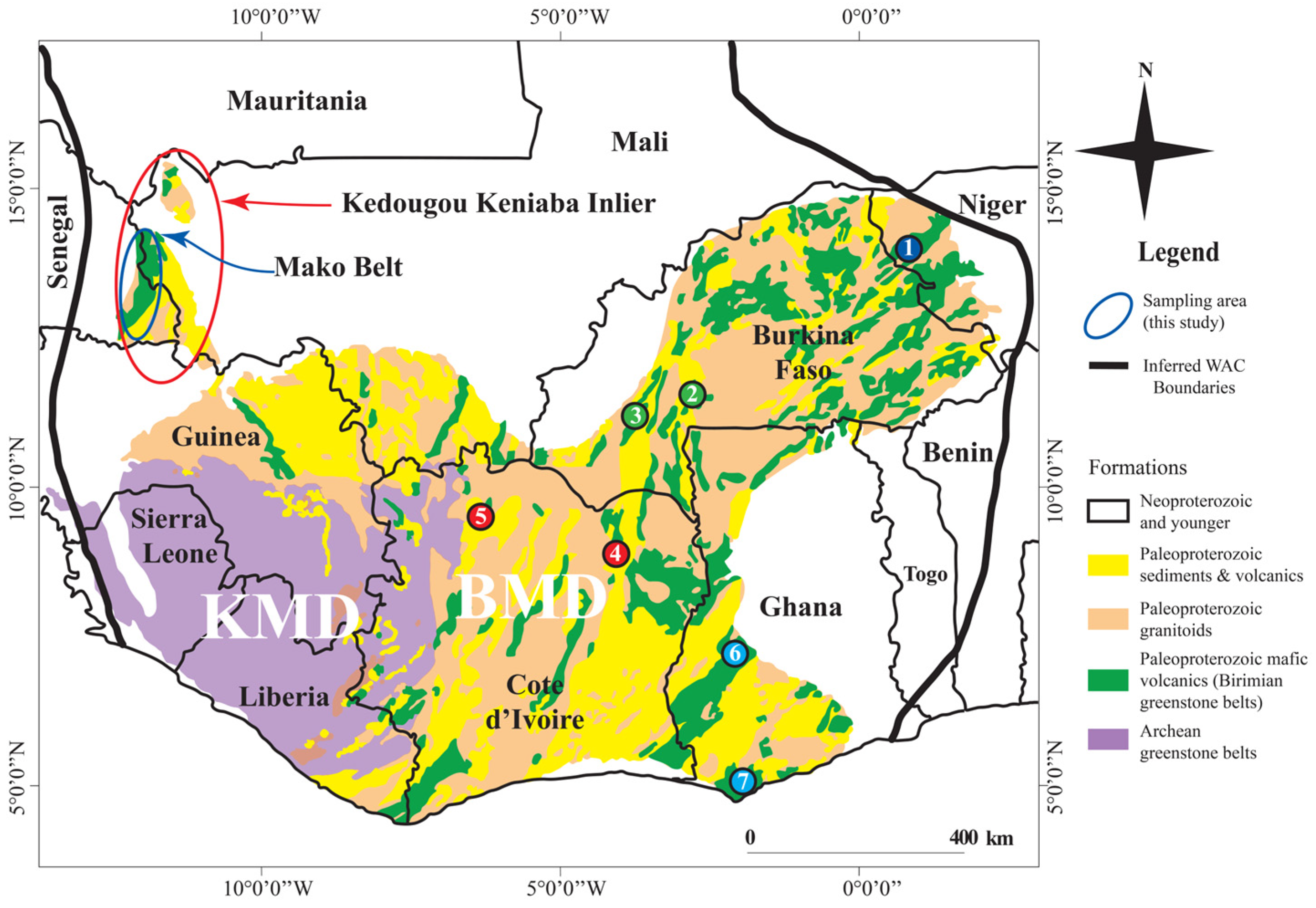
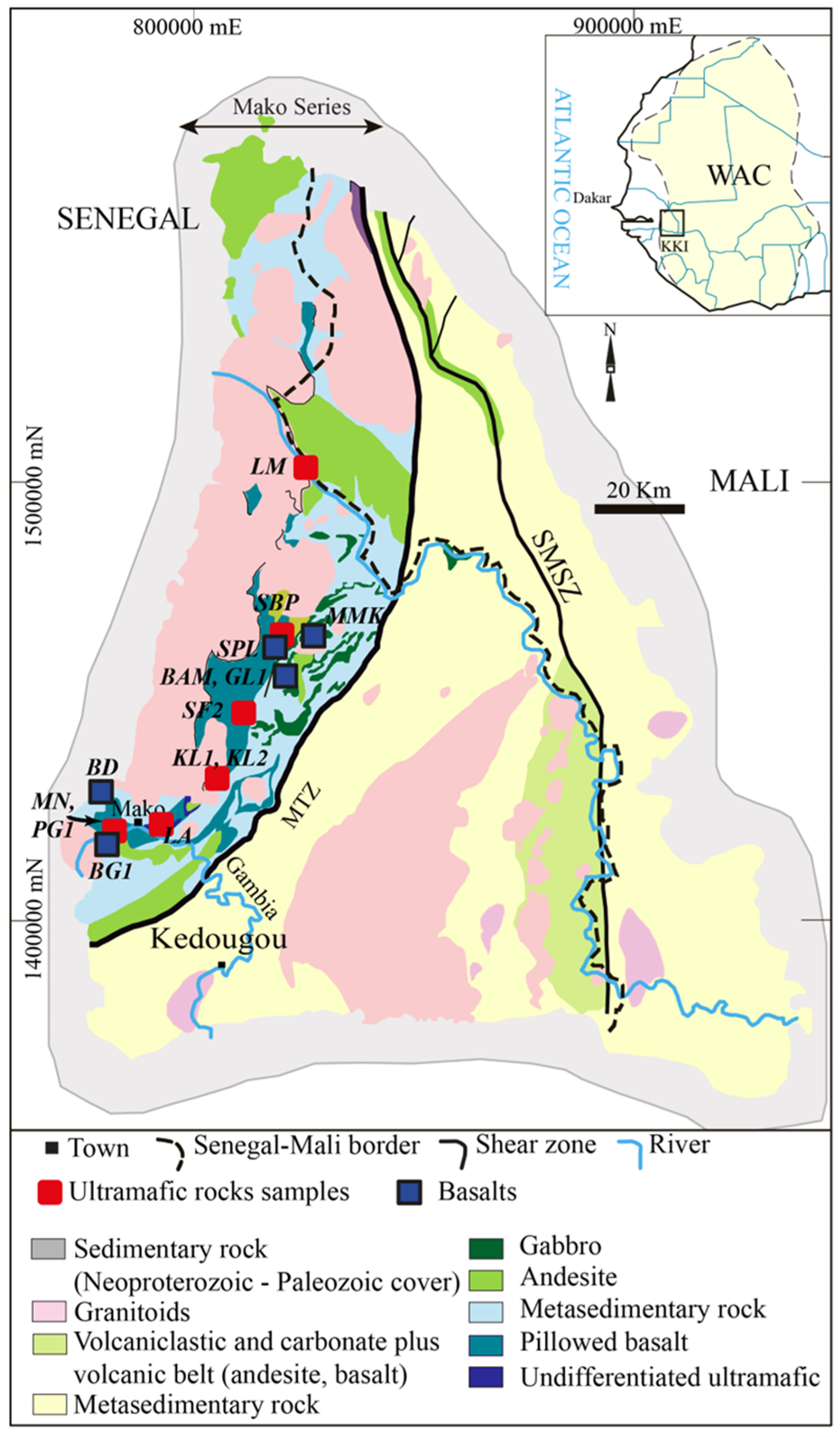
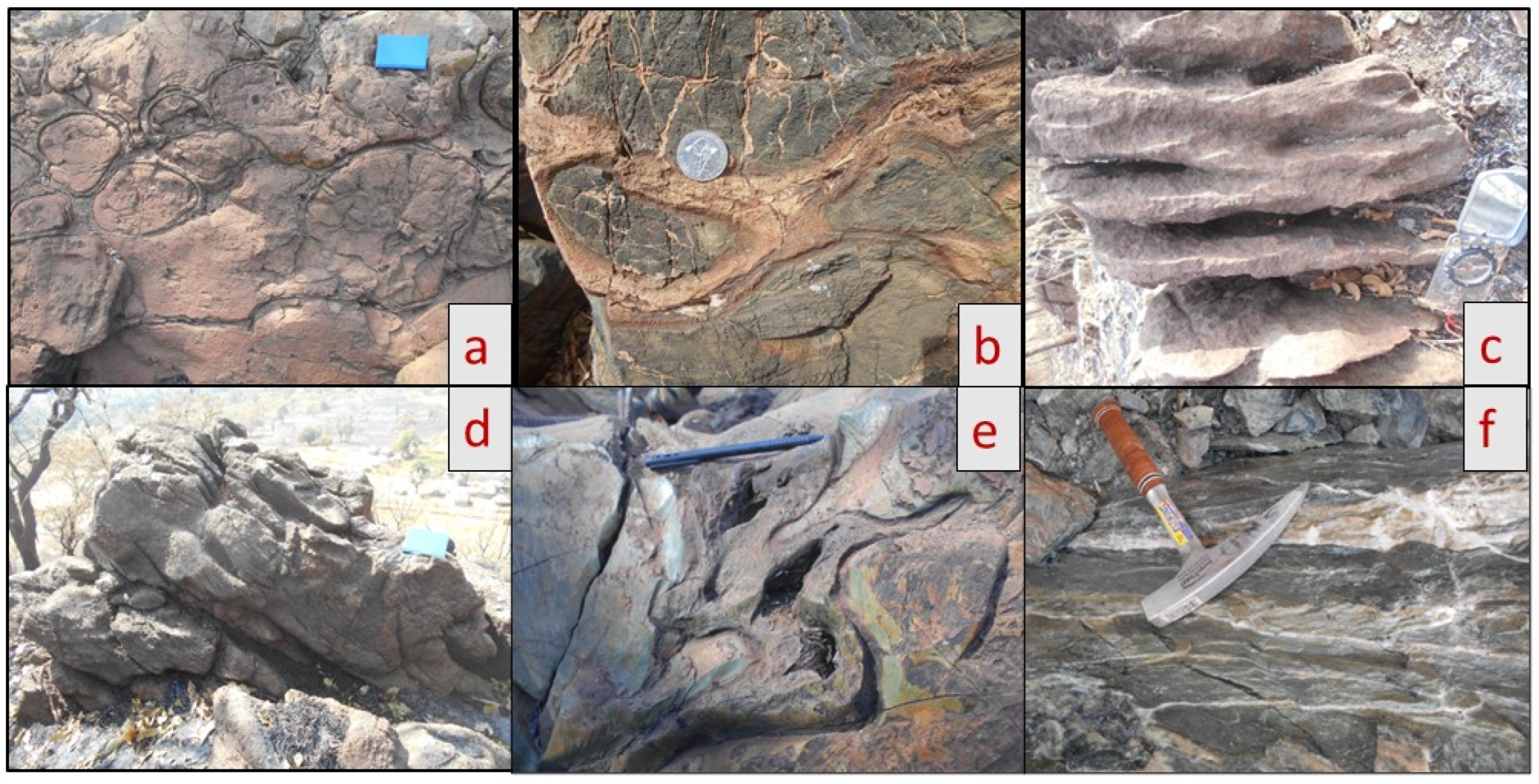
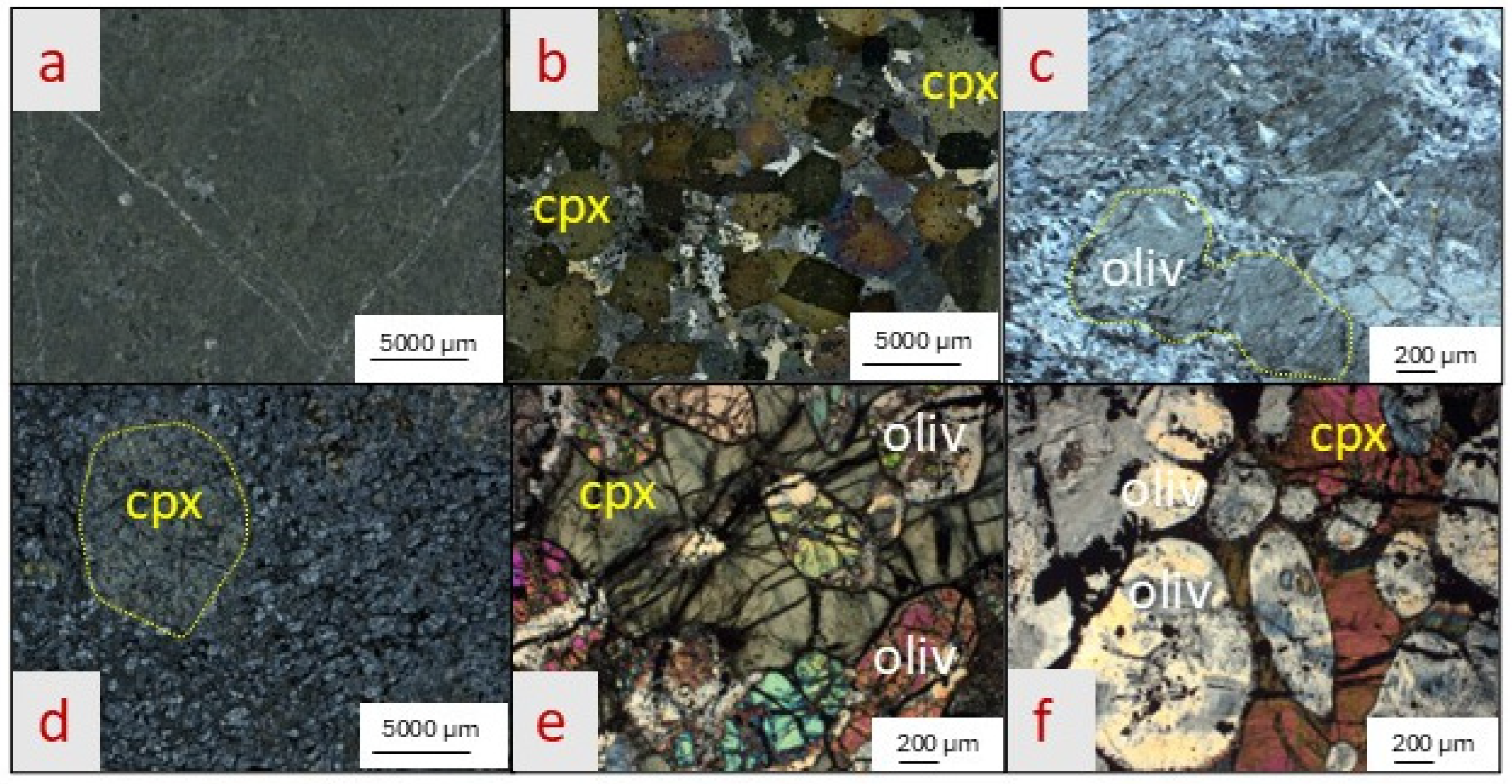
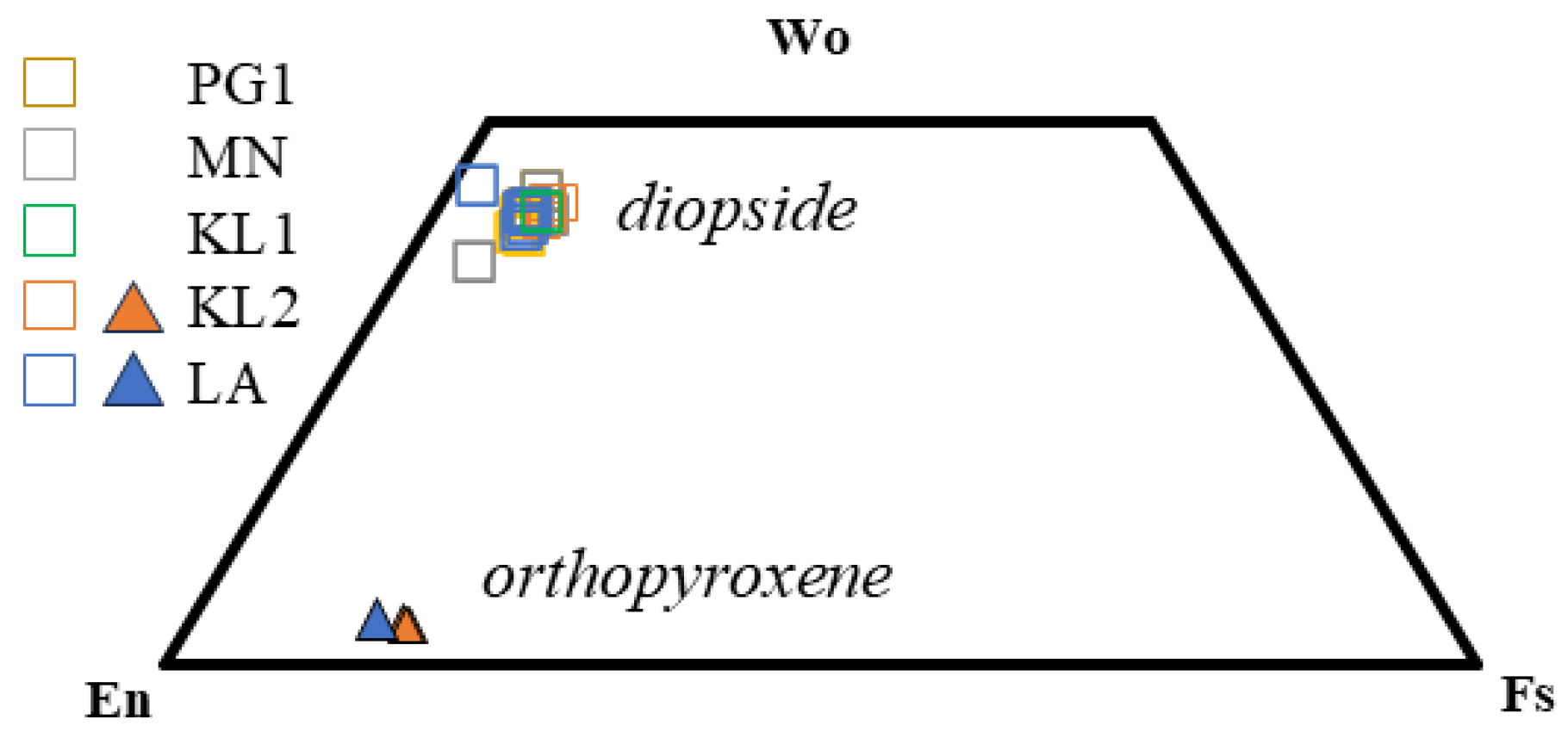
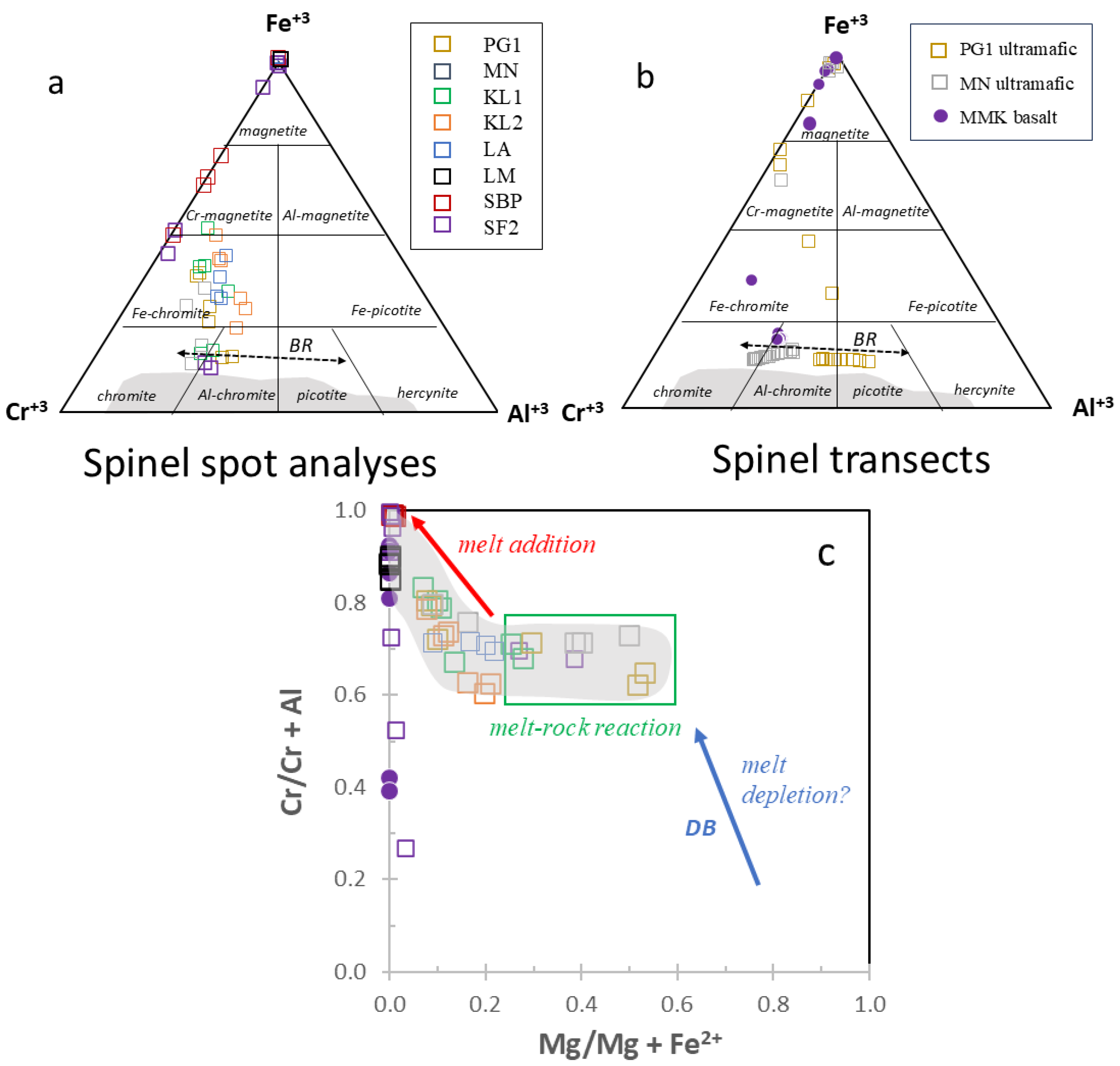
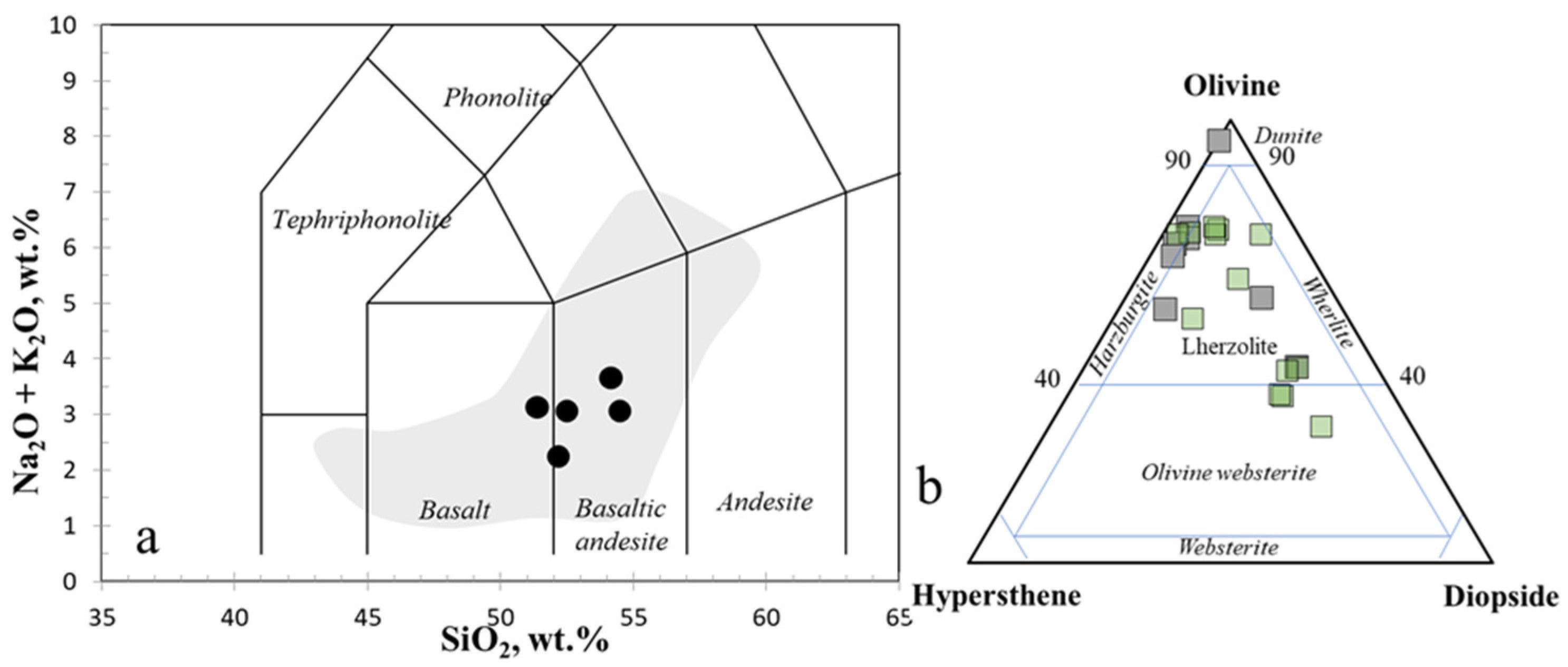
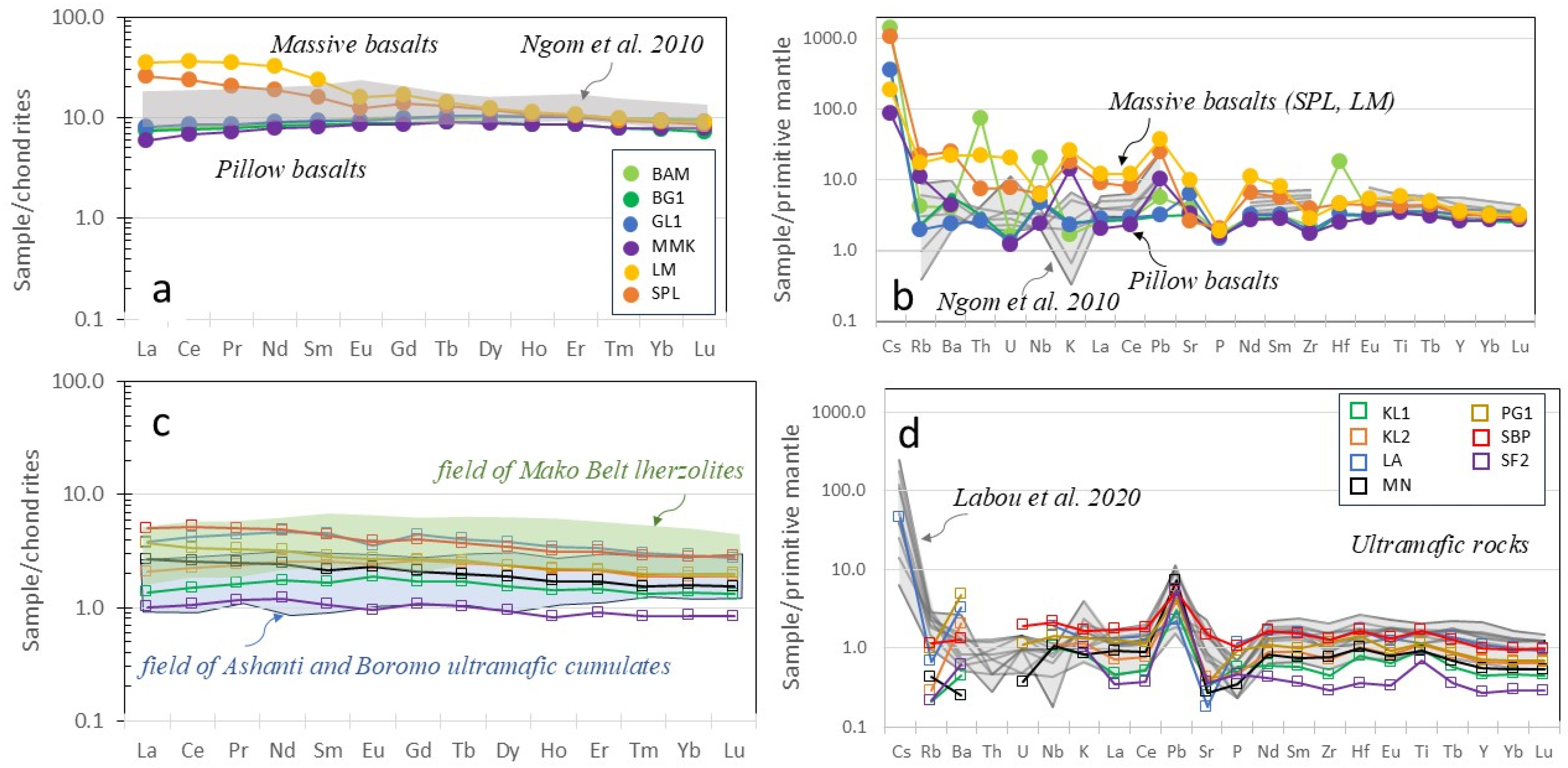


| Mako Belt Extrusive Rocks | Mako Belt Ultramafic Rocks | ||||||||||||
|---|---|---|---|---|---|---|---|---|---|---|---|---|---|
| Sample | BAM | BG1 | GL1 | MMK | LM | SPL | KL1 | KL2 | LA | MN | PG1 | SBP | SF2 |
| Lat | 13.1044 | 12.8295 | 13.1318 | 13.1847 | 13.6031 | 13.1876 | 12.9058 | 12.9048 | 12.8342 | 12.8488 | 12.8465 | 13.1897 | 12.9644 |
| Long | −12.1029 | −12.3807 | −12.0980 | −12.0671 | −12.0269 | −12.1084 | −12.2462 | −12.2450 | −12.3300 | −12.3598 | −12.3583 | −12.1105 | −12.1526 |
| SiO2 | 50.62 | 52.71 | 52.32 | 51.82 | 51.74 | 56.53 | 38.18 | 42.70 | 39.37 | 39.60 | 39.71 | 41.63 | 30.51 |
| Al2O3 | 14.88 | 14.24 | 14.26 | 15.45 | 9.97 | 12.30 | 2.15 | 1.90 | 2.28 | 2.44 | 3.23 | 4.26 | 1.65 |
| TiO2 | 0.81 | 0.74 | 0.79 | 0.74 | 1.26 | 0.90 | 0.21 | 0.24 | 0.36 | 0.20 | 0.25 | 0.36 | 0.15 |
| Fe2O3 * | 10.21 | 7.96 | 10.90 | 8.72 | 15.35 | 7.23 | 12.90 | 12.23 | 11.71 | 7.87 | 8.79 | 10.19 | 7.48 |
| MnO | 0.20 | 0.16 | 0.18 | 0.19 | 0.18 | 0.16 | 0.19 | 0.21 | 0.20 | 0.15 | 0.17 | 0.17 | 0.14 |
| MgO | 8.91 | 6.60 | 5.72 | 8.73 | 8.81 | 7.91 | 34.18 | 31.71 | 34.97 | 36.58 | 34.36 | 30.65 | 33.49 |
| CaO | 9.62 | 11.40 | 9.19 | 11.67 | 9.28 | 9.60 | 1.95 | 6.49 | 2.31 | 2.04 | 2.64 | 3.95 | 0.92 |
| Na2O | 3.00 | 2.93 | 3.40 | 1.79 | 2.14 | 2.20 | 0.12 | 0.19 | 0.12 | 0.07 | 0.09 | 0.17 | 0.09 |
| K2O | 0.05 | 0.08 | 0.07 | 0.42 | 0.79 | 0.54 | 0.03 | 0.04 | 0.04 | 0.03 | 0.04 | 0.05 | 0.03 |
| P2O5 | 0.08 | 0.07 | 0.07 | 0.07 | 0.08 | 0.09 | 0.03 | 0.02 | 0.05 | 0.02 | 0.04 | 0.05 | 0.02 |
| LOI | 2.46 | 3.13 | 2.56 | 0.98 | 0.64 | 1.24 | 9.32 | 4.50 | 8.56 | 10.09 | 9.55 | 7.49 | 22.42 |
| Total | 100.82 | 100.00 | 99.44 | 100.56 | 100.23 | 98.67 | 99.24 | 100.20 | 99.95 | 99.07 | 98.84 | 98.95 | 96.90 |
| Sc | 32.34 | 31.45 | 32.83 | 32.56 | 40.10 | 24.31 | 10.24 | 19.23 | 10.77 | 9.56 | 10.12 | 11.99 | 6.50 |
| V | 232.6 | 207.0 | 225.7 | 206.8 | 405.3 | 183.1 | 67.0 | 82.4 | 76.7 | 54.1 | 60.6 | 76.9 | 42.2 |
| Cr | 214.4 | 163.0 | 180.4 | 297.8 | 72.5 | 220.7 | 3337 | 2559 | 3364 | 2864 | 2350 | 2252 | 3882 |
| Co | 35.8 | 38.9 | 38.4 | 37.2 | 61.4 | 32.1 | 112.3 | 104.4 | 103.4 | 101.2 | 97.3 | 82.9 | 97.3 |
| Ni | 84.2 | 88.1 | 83.4 | 115.5 | 56.1 | 97.2 | 1169 | 810 | 1188 | 1500 | 1449 | 1039 | 1340 |
| Cu | 62.0 | 66.4 | 75.4 | 67.6 | 136.3 | 72.7 | 55.3 | 21.3 | 21.1 | 48.6 | 27.4 | 34.1 | 11.2 |
| Zn | 59.9 | 55.5 | 64.8 | 60.2 | 66.4 | 54.0 | 59.5 | 53.3 | 57.1 | 47.9 | 49.3 | 51.8 | 42.4 |
| Rb | 2.7 | 1.5 | 1.2 | 7.0 | 11.1 | 14.0 | 0.1 | 0.2 | 0.4 | 0.3 | 0.6 | 0.7 | 0.1 |
| Sr | 81.9 | 65.9 | 132.1 | 68.6 | 207.0 | 55.1 | 6.8 | 8.8 | 3.8 | 5.8 | 7.6 | 30.7 | 7.6 |
| Y | 14.8 | 12.3 | 14.4 | 11.8 | 16.2 | 15.1 | 2.1 | 3.1 | 5.0 | 2.5 | 3.2 | 4.5 | 1.2 |
| Zr | 24.7 | 18.1 | 20.5 | 19.4 | 31.1 | 43.0 | 5.0 | 7.8 | 14.4 | 8.5 | 13.2 | 14.4 | 3.2 |
| Nb | 14.2 | 3.7 | 3.4 | 1.7 | 4.3 | 4.5 | 0.7 | 0.8 | 1.4 | 0.8 | 1.0 | 1.5 | bdl |
| Cs | 11.2 | 2.9 | 2.9 | 0.7 | 1.5 | 8.3 | bdl | bdl | 0.35 | bdl | bdl | bdl | bdl |
| Ba | 27.7 | 40.6 | 16.7 | 30.8 | 155.9 | 173.9 | 3.1 | 14.3 | 22.7 | 1.7 | 33.2 | 9.0 | 4.3 |
| La | 1.80 | 1.75 | 1.91 | 1.40 | 8.33 | 6.15 | 0.32 | 0.49 | 0.90 | 0.63 | 0.88 | 1.19 | 0.24 |
| Ce | 4.92 | 4.70 | 5.23 | 4.14 | 21.62 | 14.52 | 0.91 | 1.36 | 2.58 | 1.57 | 2.05 | 3.20 | 0.65 |
| Pr | 0.78 | 0.75 | 0.82 | 0.68 | 3.24 | 1.97 | 0.16 | 0.23 | 0.42 | 0.24 | 0.32 | 0.47 | 0.11 |
| Nd | 4.11 | 3.87 | 4.25 | 3.62 | 14.91 | 8.99 | 0.81 | 1.20 | 2.19 | 1.14 | 1.51 | 2.27 | 0.57 |
| Sm | 1.40 | 1.31 | 1.40 | 1.24 | 3.58 | 2.45 | 0.26 | 0.39 | 0.70 | 0.33 | 0.44 | 0.67 | 0.16 |
| Eu | 0.56 | 0.51 | 0.54 | 0.48 | 0.89 | 0.72 | 0.11 | 0.14 | 0.20 | 0.13 | 0.16 | 0.22 | 0.06 |
| Gd | 2.05 | 1.82 | 2.01 | 1.72 | 3.38 | 2.88 | 0.35 | 0.53 | 0.91 | 0.43 | 0.54 | 0.82 | 0.22 |
| Tb | 0.38 | 0.34 | 0.39 | 0.33 | 0.54 | 0.48 | 0.06 | 0.09 | 0.15 | 0.07 | 0.10 | 0.14 | 0.04 |
| Dy | 2.60 | 2.27 | 2.62 | 2.25 | 3.20 | 2.99 | 0.39 | 0.59 | 0.96 | 0.48 | 0.60 | 0.87 | 0.24 |
| Ho | 0.57 | 0.49 | 0.57 | 0.48 | 0.64 | 0.60 | 0.08 | 0.12 | 0.20 | 0.10 | 0.12 | 0.18 | 0.05 |
| Er | 1.73 | 1.42 | 1.69 | 1.42 | 1.81 | 1.71 | 0.24 | 0.35 | 0.56 | 0.28 | 0.36 | 0.52 | 0.15 |
| Tm | 0.25 | 0.20 | 0.24 | 0.20 | 0.25 | 0.24 | 0.03 | 0.05 | 0.08 | 0.04 | 0.05 | 0.07 | 0.02 |
| Yb | 1.65 | 1.29 | 1.57 | 1.35 | 1.58 | 1.50 | 0.23 | 0.32 | 0.49 | 0.27 | 0.34 | 0.48 | 0.14 |
| Lu | 0.24 | 0.18 | 0.23 | 0.20 | 0.23 | 0.22 | 0.03 | 0.05 | 0.07 | 0.04 | 0.05 | 0.07 | 0.02 |
| Hf | 5.49 | 1.00 | 1.01 | 0.77 | 1.43 | 1.42 | 0.24 | 0.31 | 0.54 | 0.31 | 0.44 | 0.51 | 0.11 |
| Ta | 15.58 | 4.04 | 4.38 | 2.44 | 4.09 | 3.83 | 1.20 | 1.16 | 1.66 | 1.44 | 1.17 | 2.04 | 0.67 |
| Pb | 0.40 | 0.22 | 0.22 | 0.72 | 2.64 | 1.78 | 0.21 | 0.29 | 0.16 | 0.51 | 0.32 | 0.37 | 0.39 |
| Th | 6.28 | 0.27 | 0.22 | 0.00 | 1.85 | 0.62 | bdl | bdl | bdl | bdl | bdl | bdl | bdl |
| U | 0.034 | 0.029 | 0.028 | 0.026 | 0.435 | 0.163 | bdl | bdl | bdl | 0.008 | 0.023 | 0.041 | bdl |
Disclaimer/Publisher’s Note: The statements, opinions and data contained in all publications are solely those of the individual author(s) and contributor(s) and not of MDPI and/or the editor(s). MDPI and/or the editor(s) disclaim responsibility for any injury to people or property resulting from any ideas, methods, instructions or products referred to in the content. |
© 2025 by the authors. Licensee MDPI, Basel, Switzerland. This article is an open access article distributed under the terms and conditions of the Creative Commons Attribution (CC BY) license (https://creativecommons.org/licenses/by/4.0/).
Share and Cite
Dia, I.; Furman, T.; Sayit, K.; Bowden, S.; Gueye, M.; Faye, C.I.; Vanderhaeghe, O. Paleoproterozoic Mafic and Ultramafic Rocks from the Mako Belt, Senegal: Implications for Back-Arc Basin Origin. Minerals 2025, 15, 1057. https://doi.org/10.3390/min15101057
Dia I, Furman T, Sayit K, Bowden S, Gueye M, Faye CI, Vanderhaeghe O. Paleoproterozoic Mafic and Ultramafic Rocks from the Mako Belt, Senegal: Implications for Back-Arc Basin Origin. Minerals. 2025; 15(10):1057. https://doi.org/10.3390/min15101057
Chicago/Turabian StyleDia, Ibrahima, Tanya Furman, Kaan Sayit, Shelby Bowden, Mamadou Gueye, Cheikh Ibrahima Faye, and Olivier Vanderhaeghe. 2025. "Paleoproterozoic Mafic and Ultramafic Rocks from the Mako Belt, Senegal: Implications for Back-Arc Basin Origin" Minerals 15, no. 10: 1057. https://doi.org/10.3390/min15101057
APA StyleDia, I., Furman, T., Sayit, K., Bowden, S., Gueye, M., Faye, C. I., & Vanderhaeghe, O. (2025). Paleoproterozoic Mafic and Ultramafic Rocks from the Mako Belt, Senegal: Implications for Back-Arc Basin Origin. Minerals, 15(10), 1057. https://doi.org/10.3390/min15101057






